Communication Strategies and Convergence Industry Analysis: A Report
VerifiedAdded on 2023/06/04
|29
|5728
|256
Report
AI Summary
This report examines the application of communication strategies within a convergence industry, analyzing various marketing techniques and their effectiveness. The report delves into the concepts of technological convergence, siloed sectors versus convergent industries, and the benefits of integration. It explores changes in consumer behavior, the role of integrated marketing communication (IMC), and the importance of advertising, public relations, direct marketing, sales, and market research. The report also covers digital marketing strategies such as social media marketing and content marketing, highlighting their significance in the modern marketing landscape, particularly in the Australian market. Furthermore, the report provides examples of how companies like Disney and Nestle apply these strategies to achieve their business objectives. The report also covers tools and techniques of the traditional sector considered for integrated marketing communication environment in context of the digital marketing.
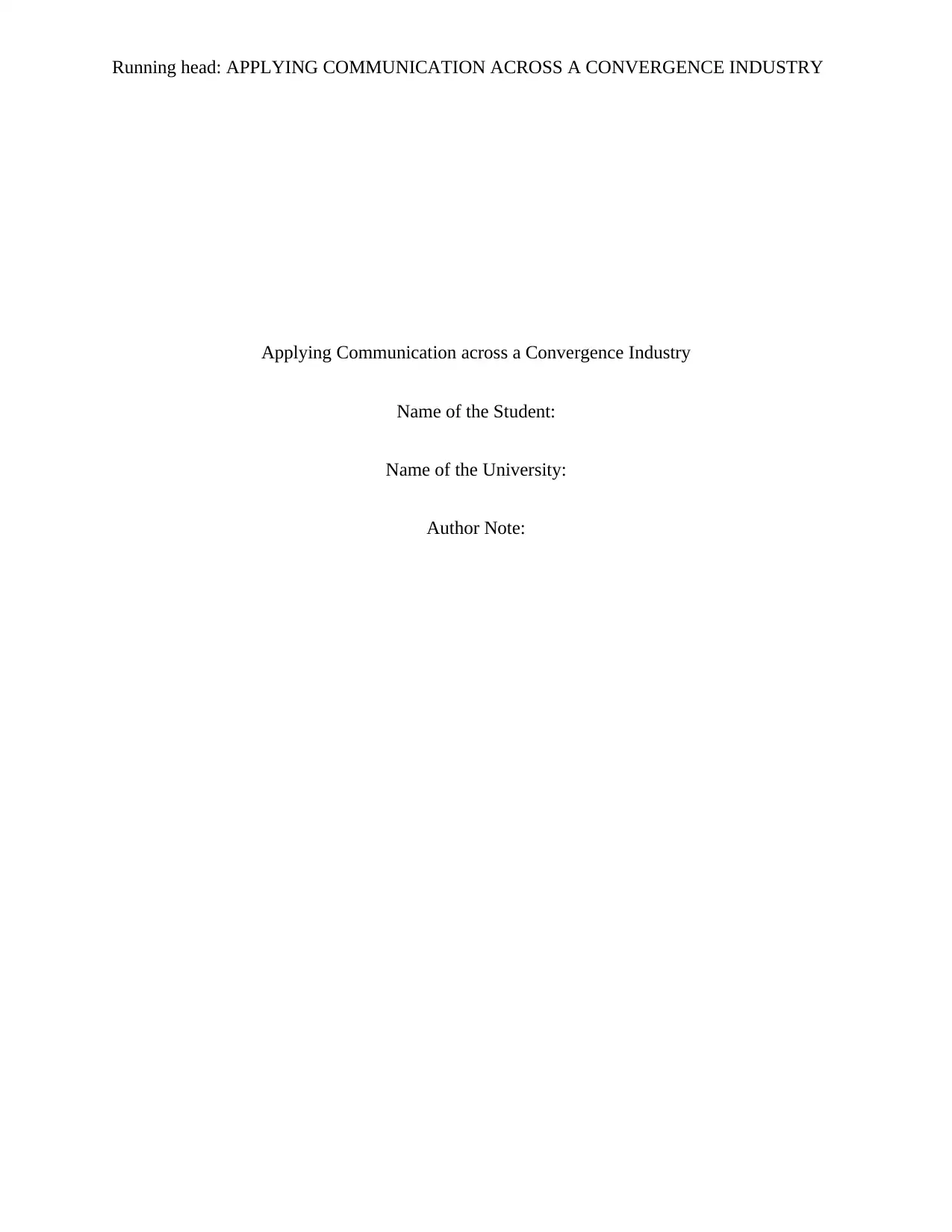
Running head: APPLYING COMMUNICATION ACROSS A CONVERGENCE INDUSTRY
Applying Communication across a Convergence Industry
Name of the Student:
Name of the University:
Author Note:
Applying Communication across a Convergence Industry
Name of the Student:
Name of the University:
Author Note:
Paraphrase This Document
Need a fresh take? Get an instant paraphrase of this document with our AI Paraphraser

1APPLYING COMMUNICATION ACROSS A CONVERGENCE INDUSTRY
Table of Contents
Part A...............................................................................................................................................3
Answer 1:.........................................................................................................................................3
Answer 2:.........................................................................................................................................3
Answer 3:.........................................................................................................................................3
Answer 4(a):....................................................................................................................................3
Answer to 4(b).................................................................................................................................4
Answer to 5(a).................................................................................................................................4
Answer to 5(b).................................................................................................................................5
Answer to 6(a):................................................................................................................................5
Answer to 6(b):................................................................................................................................5
Answer to 6 (c)................................................................................................................................6
Answer to 7......................................................................................................................................6
Answer to 8 (a)................................................................................................................................6
Answer to 8(b).................................................................................................................................7
Answer to 8(c).................................................................................................................................7
Answer to 9 (a)................................................................................................................................8
Answer to 9 (b)................................................................................................................................8
Answer to 9 (c)................................................................................................................................8
Answer to 9 (d)................................................................................................................................8
Answer to 9(e).................................................................................................................................9
Answer to 10 (a)..............................................................................................................................9
Answer to 10 (b)............................................................................................................................10
Answer to 10 (c)............................................................................................................................10
Answer to 10(d).............................................................................................................................11
Answer to 10 (e)............................................................................................................................15
Answer to 10 (f).............................................................................................................................15
Answer to 11 (a)............................................................................................................................16
Answer to 11(b).............................................................................................................................16
Table of Contents
Part A...............................................................................................................................................3
Answer 1:.........................................................................................................................................3
Answer 2:.........................................................................................................................................3
Answer 3:.........................................................................................................................................3
Answer 4(a):....................................................................................................................................3
Answer to 4(b).................................................................................................................................4
Answer to 5(a).................................................................................................................................4
Answer to 5(b).................................................................................................................................5
Answer to 6(a):................................................................................................................................5
Answer to 6(b):................................................................................................................................5
Answer to 6 (c)................................................................................................................................6
Answer to 7......................................................................................................................................6
Answer to 8 (a)................................................................................................................................6
Answer to 8(b).................................................................................................................................7
Answer to 8(c).................................................................................................................................7
Answer to 9 (a)................................................................................................................................8
Answer to 9 (b)................................................................................................................................8
Answer to 9 (c)................................................................................................................................8
Answer to 9 (d)................................................................................................................................8
Answer to 9(e).................................................................................................................................9
Answer to 10 (a)..............................................................................................................................9
Answer to 10 (b)............................................................................................................................10
Answer to 10 (c)............................................................................................................................10
Answer to 10(d).............................................................................................................................11
Answer to 10 (e)............................................................................................................................15
Answer to 10 (f).............................................................................................................................15
Answer to 11 (a)............................................................................................................................16
Answer to 11(b).............................................................................................................................16
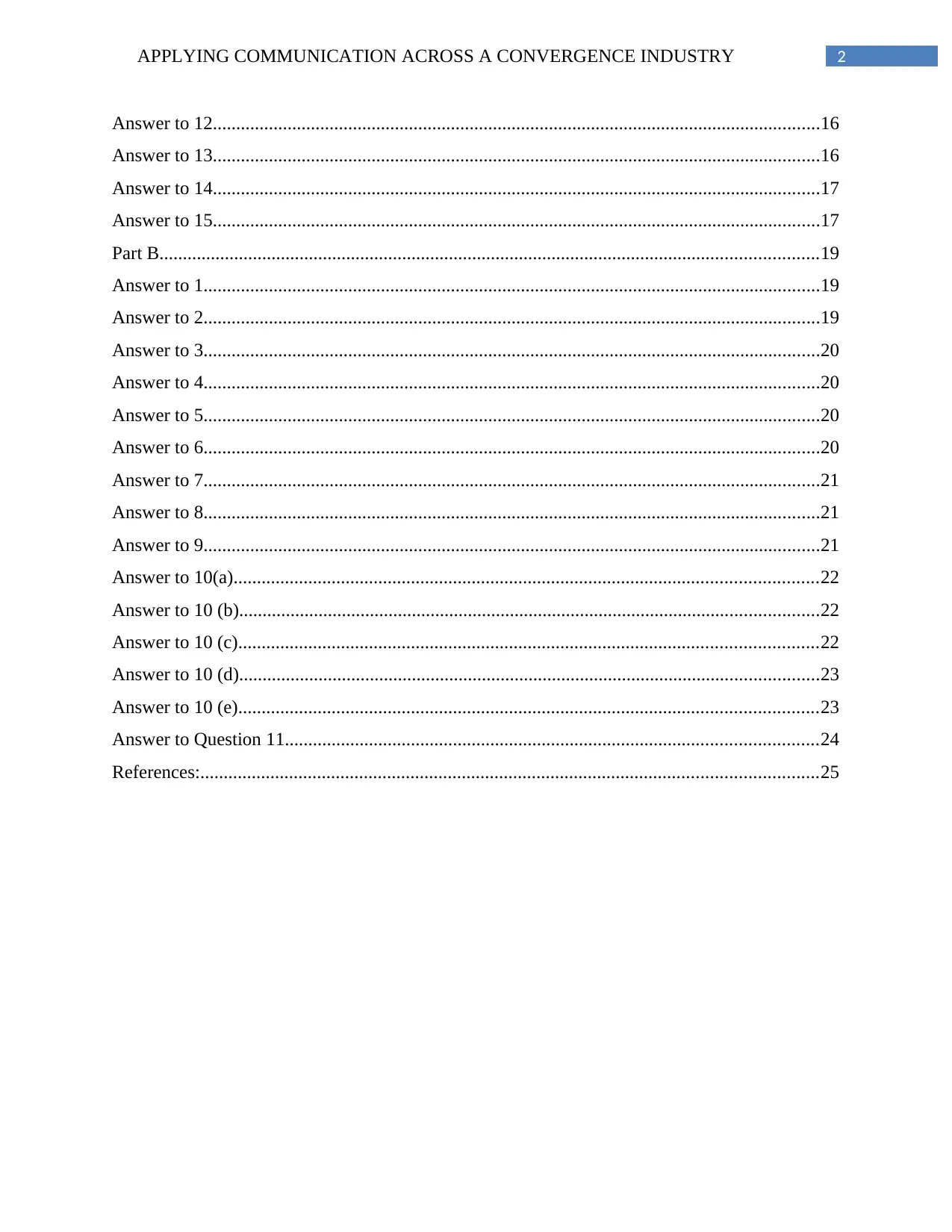
2APPLYING COMMUNICATION ACROSS A CONVERGENCE INDUSTRY
Answer to 12..................................................................................................................................16
Answer to 13..................................................................................................................................16
Answer to 14..................................................................................................................................17
Answer to 15..................................................................................................................................17
Part B.............................................................................................................................................19
Answer to 1....................................................................................................................................19
Answer to 2....................................................................................................................................19
Answer to 3....................................................................................................................................20
Answer to 4....................................................................................................................................20
Answer to 5....................................................................................................................................20
Answer to 6....................................................................................................................................20
Answer to 7....................................................................................................................................21
Answer to 8....................................................................................................................................21
Answer to 9....................................................................................................................................21
Answer to 10(a).............................................................................................................................22
Answer to 10 (b)............................................................................................................................22
Answer to 10 (c)............................................................................................................................22
Answer to 10 (d)............................................................................................................................23
Answer to 10 (e)............................................................................................................................23
Answer to Question 11..................................................................................................................24
References:....................................................................................................................................25
Answer to 12..................................................................................................................................16
Answer to 13..................................................................................................................................16
Answer to 14..................................................................................................................................17
Answer to 15..................................................................................................................................17
Part B.............................................................................................................................................19
Answer to 1....................................................................................................................................19
Answer to 2....................................................................................................................................19
Answer to 3....................................................................................................................................20
Answer to 4....................................................................................................................................20
Answer to 5....................................................................................................................................20
Answer to 6....................................................................................................................................20
Answer to 7....................................................................................................................................21
Answer to 8....................................................................................................................................21
Answer to 9....................................................................................................................................21
Answer to 10(a).............................................................................................................................22
Answer to 10 (b)............................................................................................................................22
Answer to 10 (c)............................................................................................................................22
Answer to 10 (d)............................................................................................................................23
Answer to 10 (e)............................................................................................................................23
Answer to Question 11..................................................................................................................24
References:....................................................................................................................................25
⊘ This is a preview!⊘
Do you want full access?
Subscribe today to unlock all pages.

Trusted by 1+ million students worldwide
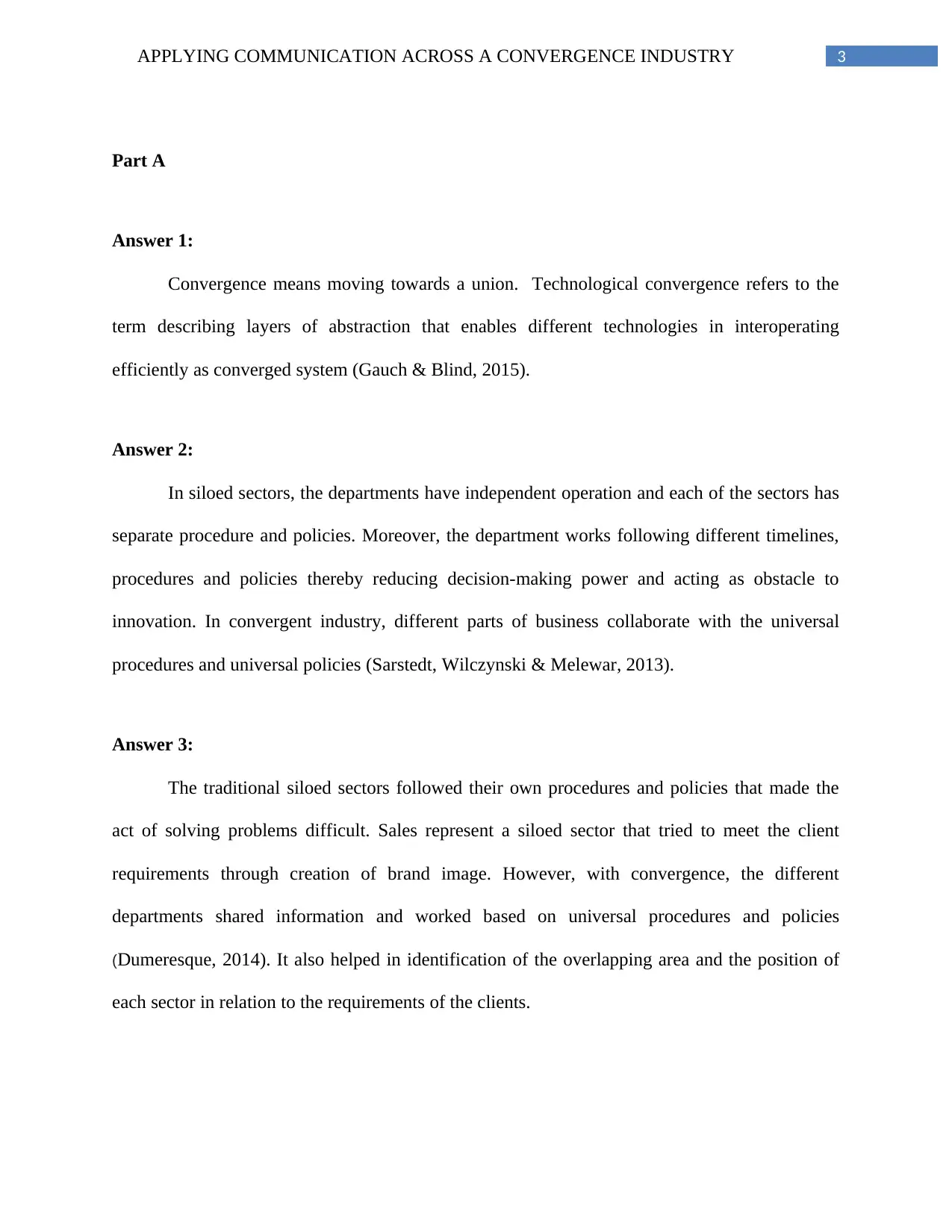
3APPLYING COMMUNICATION ACROSS A CONVERGENCE INDUSTRY
Part A
Answer 1:
Convergence means moving towards a union. Technological convergence refers to the
term describing layers of abstraction that enables different technologies in interoperating
efficiently as converged system (Gauch & Blind, 2015).
Answer 2:
In siloed sectors, the departments have independent operation and each of the sectors has
separate procedure and policies. Moreover, the department works following different timelines,
procedures and policies thereby reducing decision-making power and acting as obstacle to
innovation. In convergent industry, different parts of business collaborate with the universal
procedures and universal policies (Sarstedt, Wilczynski & Melewar, 2013).
Answer 3:
The traditional siloed sectors followed their own procedures and policies that made the
act of solving problems difficult. Sales represent a siloed sector that tried to meet the client
requirements through creation of brand image. However, with convergence, the different
departments shared information and worked based on universal procedures and policies
(Dumeresque, 2014). It also helped in identification of the overlapping area and the position of
each sector in relation to the requirements of the clients.
Part A
Answer 1:
Convergence means moving towards a union. Technological convergence refers to the
term describing layers of abstraction that enables different technologies in interoperating
efficiently as converged system (Gauch & Blind, 2015).
Answer 2:
In siloed sectors, the departments have independent operation and each of the sectors has
separate procedure and policies. Moreover, the department works following different timelines,
procedures and policies thereby reducing decision-making power and acting as obstacle to
innovation. In convergent industry, different parts of business collaborate with the universal
procedures and universal policies (Sarstedt, Wilczynski & Melewar, 2013).
Answer 3:
The traditional siloed sectors followed their own procedures and policies that made the
act of solving problems difficult. Sales represent a siloed sector that tried to meet the client
requirements through creation of brand image. However, with convergence, the different
departments shared information and worked based on universal procedures and policies
(Dumeresque, 2014). It also helped in identification of the overlapping area and the position of
each sector in relation to the requirements of the clients.
Paraphrase This Document
Need a fresh take? Get an instant paraphrase of this document with our AI Paraphraser
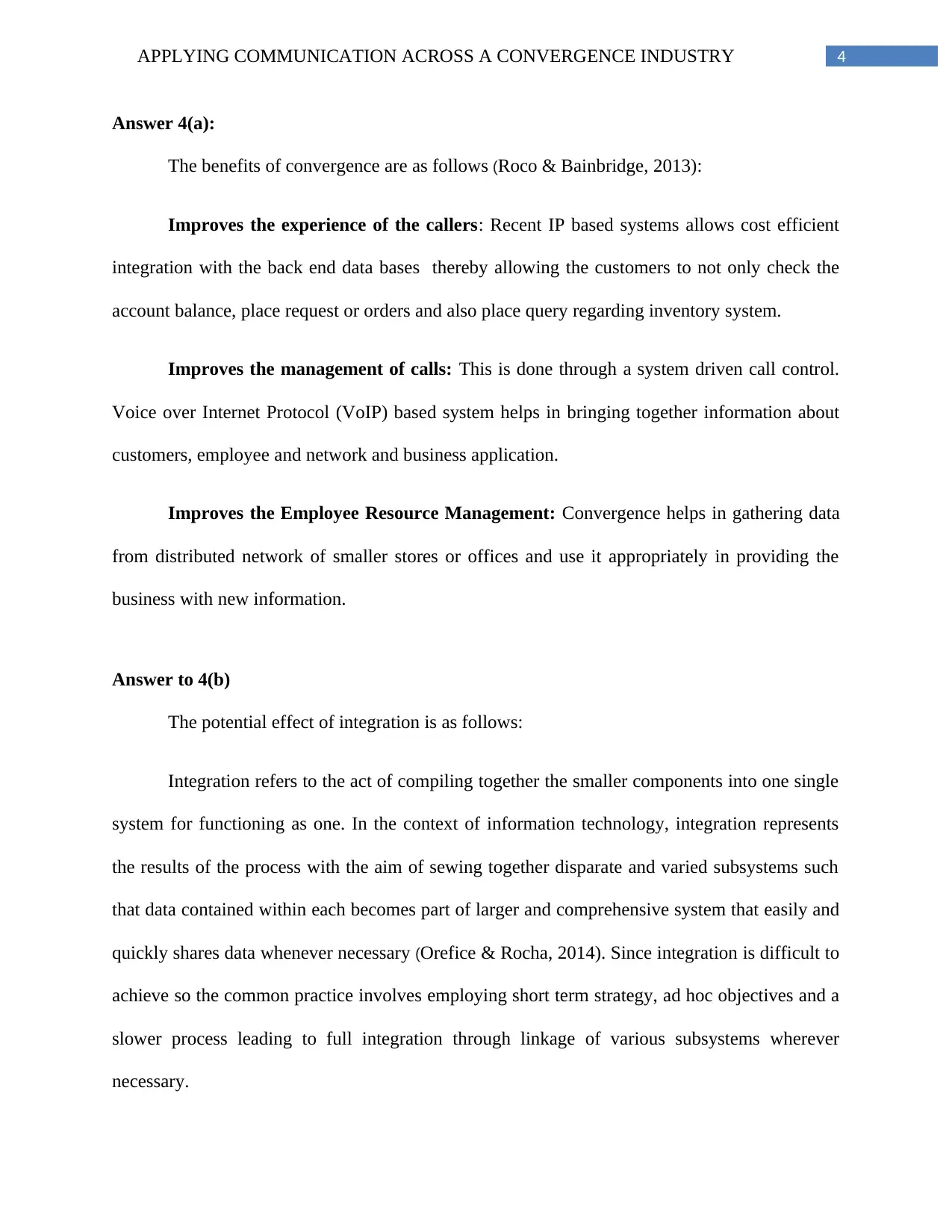
4APPLYING COMMUNICATION ACROSS A CONVERGENCE INDUSTRY
Answer 4(a):
The benefits of convergence are as follows (Roco & Bainbridge, 2013):
Improves the experience of the callers: Recent IP based systems allows cost efficient
integration with the back end data bases thereby allowing the customers to not only check the
account balance, place request or orders and also place query regarding inventory system.
Improves the management of calls: This is done through a system driven call control.
Voice over Internet Protocol (VoIP) based system helps in bringing together information about
customers, employee and network and business application.
Improves the Employee Resource Management: Convergence helps in gathering data
from distributed network of smaller stores or offices and use it appropriately in providing the
business with new information.
Answer to 4(b)
The potential effect of integration is as follows:
Integration refers to the act of compiling together the smaller components into one single
system for functioning as one. In the context of information technology, integration represents
the results of the process with the aim of sewing together disparate and varied subsystems such
that data contained within each becomes part of larger and comprehensive system that easily and
quickly shares data whenever necessary (Orefice & Rocha, 2014). Since integration is difficult to
achieve so the common practice involves employing short term strategy, ad hoc objectives and a
slower process leading to full integration through linkage of various subsystems wherever
necessary.
Answer 4(a):
The benefits of convergence are as follows (Roco & Bainbridge, 2013):
Improves the experience of the callers: Recent IP based systems allows cost efficient
integration with the back end data bases thereby allowing the customers to not only check the
account balance, place request or orders and also place query regarding inventory system.
Improves the management of calls: This is done through a system driven call control.
Voice over Internet Protocol (VoIP) based system helps in bringing together information about
customers, employee and network and business application.
Improves the Employee Resource Management: Convergence helps in gathering data
from distributed network of smaller stores or offices and use it appropriately in providing the
business with new information.
Answer to 4(b)
The potential effect of integration is as follows:
Integration refers to the act of compiling together the smaller components into one single
system for functioning as one. In the context of information technology, integration represents
the results of the process with the aim of sewing together disparate and varied subsystems such
that data contained within each becomes part of larger and comprehensive system that easily and
quickly shares data whenever necessary (Orefice & Rocha, 2014). Since integration is difficult to
achieve so the common practice involves employing short term strategy, ad hoc objectives and a
slower process leading to full integration through linkage of various subsystems wherever
necessary.
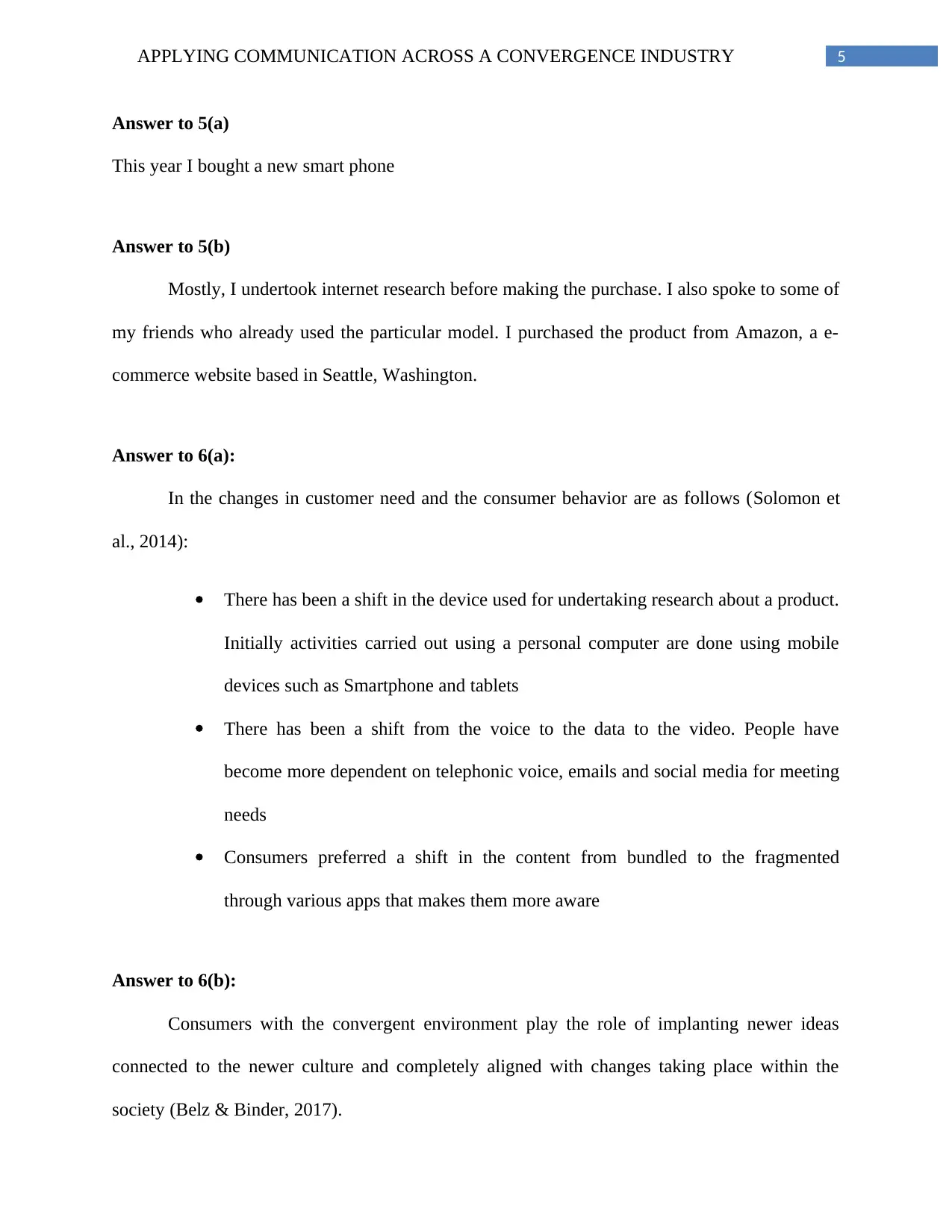
5APPLYING COMMUNICATION ACROSS A CONVERGENCE INDUSTRY
Answer to 5(a)
This year I bought a new smart phone
Answer to 5(b)
Mostly, I undertook internet research before making the purchase. I also spoke to some of
my friends who already used the particular model. I purchased the product from Amazon, a e-
commerce website based in Seattle, Washington.
Answer to 6(a):
In the changes in customer need and the consumer behavior are as follows (Solomon et
al., 2014):
There has been a shift in the device used for undertaking research about a product.
Initially activities carried out using a personal computer are done using mobile
devices such as Smartphone and tablets
There has been a shift from the voice to the data to the video. People have
become more dependent on telephonic voice, emails and social media for meeting
needs
Consumers preferred a shift in the content from bundled to the fragmented
through various apps that makes them more aware
Answer to 6(b):
Consumers with the convergent environment play the role of implanting newer ideas
connected to the newer culture and completely aligned with changes taking place within the
society (Belz & Binder, 2017).
Answer to 5(a)
This year I bought a new smart phone
Answer to 5(b)
Mostly, I undertook internet research before making the purchase. I also spoke to some of
my friends who already used the particular model. I purchased the product from Amazon, a e-
commerce website based in Seattle, Washington.
Answer to 6(a):
In the changes in customer need and the consumer behavior are as follows (Solomon et
al., 2014):
There has been a shift in the device used for undertaking research about a product.
Initially activities carried out using a personal computer are done using mobile
devices such as Smartphone and tablets
There has been a shift from the voice to the data to the video. People have
become more dependent on telephonic voice, emails and social media for meeting
needs
Consumers preferred a shift in the content from bundled to the fragmented
through various apps that makes them more aware
Answer to 6(b):
Consumers with the convergent environment play the role of implanting newer ideas
connected to the newer culture and completely aligned with changes taking place within the
society (Belz & Binder, 2017).
⊘ This is a preview!⊘
Do you want full access?
Subscribe today to unlock all pages.

Trusted by 1+ million students worldwide
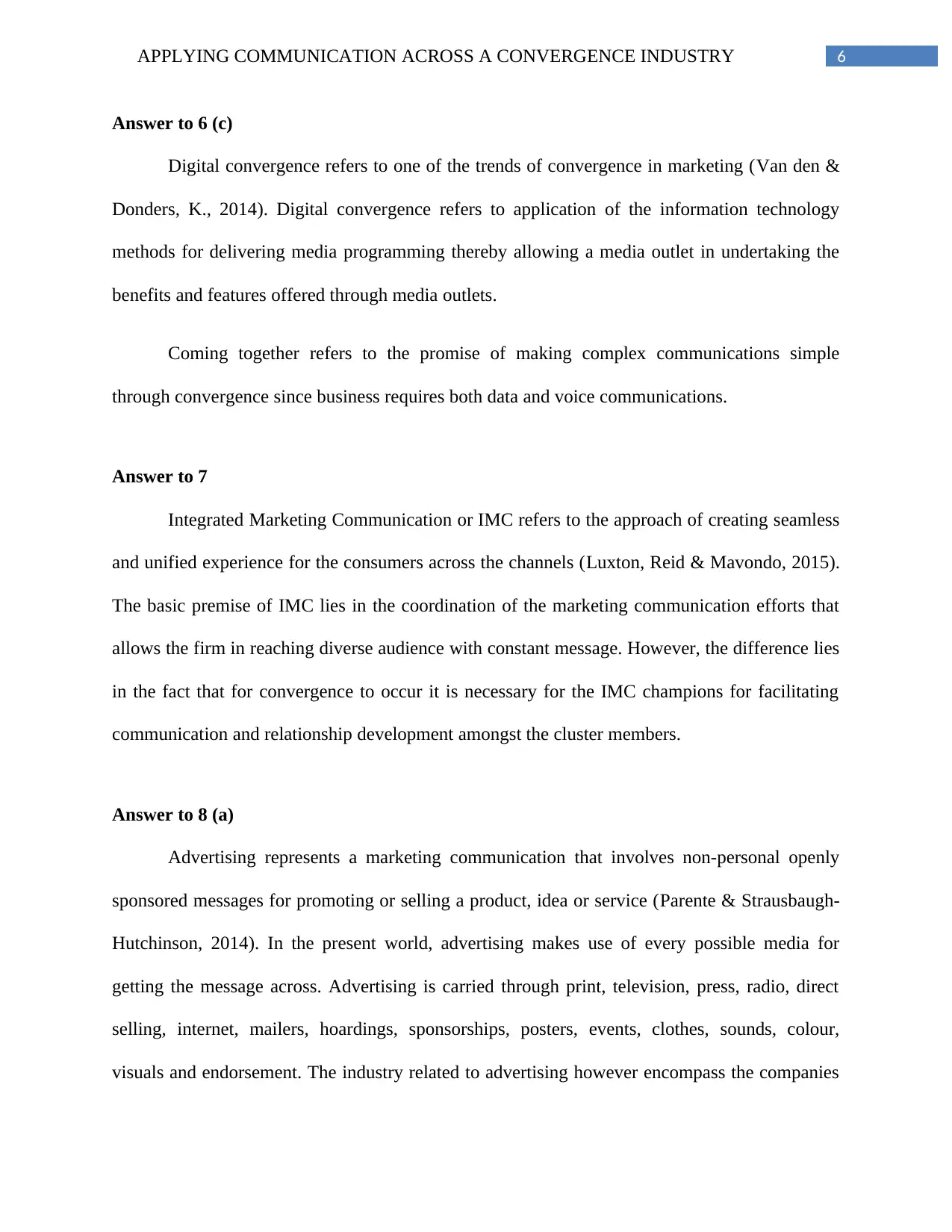
6APPLYING COMMUNICATION ACROSS A CONVERGENCE INDUSTRY
Answer to 6 (c)
Digital convergence refers to one of the trends of convergence in marketing (Van den &
Donders, K., 2014). Digital convergence refers to application of the information technology
methods for delivering media programming thereby allowing a media outlet in undertaking the
benefits and features offered through media outlets.
Coming together refers to the promise of making complex communications simple
through convergence since business requires both data and voice communications.
Answer to 7
Integrated Marketing Communication or IMC refers to the approach of creating seamless
and unified experience for the consumers across the channels (Luxton, Reid & Mavondo, 2015).
The basic premise of IMC lies in the coordination of the marketing communication efforts that
allows the firm in reaching diverse audience with constant message. However, the difference lies
in the fact that for convergence to occur it is necessary for the IMC champions for facilitating
communication and relationship development amongst the cluster members.
Answer to 8 (a)
Advertising represents a marketing communication that involves non-personal openly
sponsored messages for promoting or selling a product, idea or service (Parente & Strausbaugh-
Hutchinson, 2014). In the present world, advertising makes use of every possible media for
getting the message across. Advertising is carried through print, television, press, radio, direct
selling, internet, mailers, hoardings, sponsorships, posters, events, clothes, sounds, colour,
visuals and endorsement. The industry related to advertising however encompass the companies
Answer to 6 (c)
Digital convergence refers to one of the trends of convergence in marketing (Van den &
Donders, K., 2014). Digital convergence refers to application of the information technology
methods for delivering media programming thereby allowing a media outlet in undertaking the
benefits and features offered through media outlets.
Coming together refers to the promise of making complex communications simple
through convergence since business requires both data and voice communications.
Answer to 7
Integrated Marketing Communication or IMC refers to the approach of creating seamless
and unified experience for the consumers across the channels (Luxton, Reid & Mavondo, 2015).
The basic premise of IMC lies in the coordination of the marketing communication efforts that
allows the firm in reaching diverse audience with constant message. However, the difference lies
in the fact that for convergence to occur it is necessary for the IMC champions for facilitating
communication and relationship development amongst the cluster members.
Answer to 8 (a)
Advertising represents a marketing communication that involves non-personal openly
sponsored messages for promoting or selling a product, idea or service (Parente & Strausbaugh-
Hutchinson, 2014). In the present world, advertising makes use of every possible media for
getting the message across. Advertising is carried through print, television, press, radio, direct
selling, internet, mailers, hoardings, sponsorships, posters, events, clothes, sounds, colour,
visuals and endorsement. The industry related to advertising however encompass the companies
Paraphrase This Document
Need a fresh take? Get an instant paraphrase of this document with our AI Paraphraser
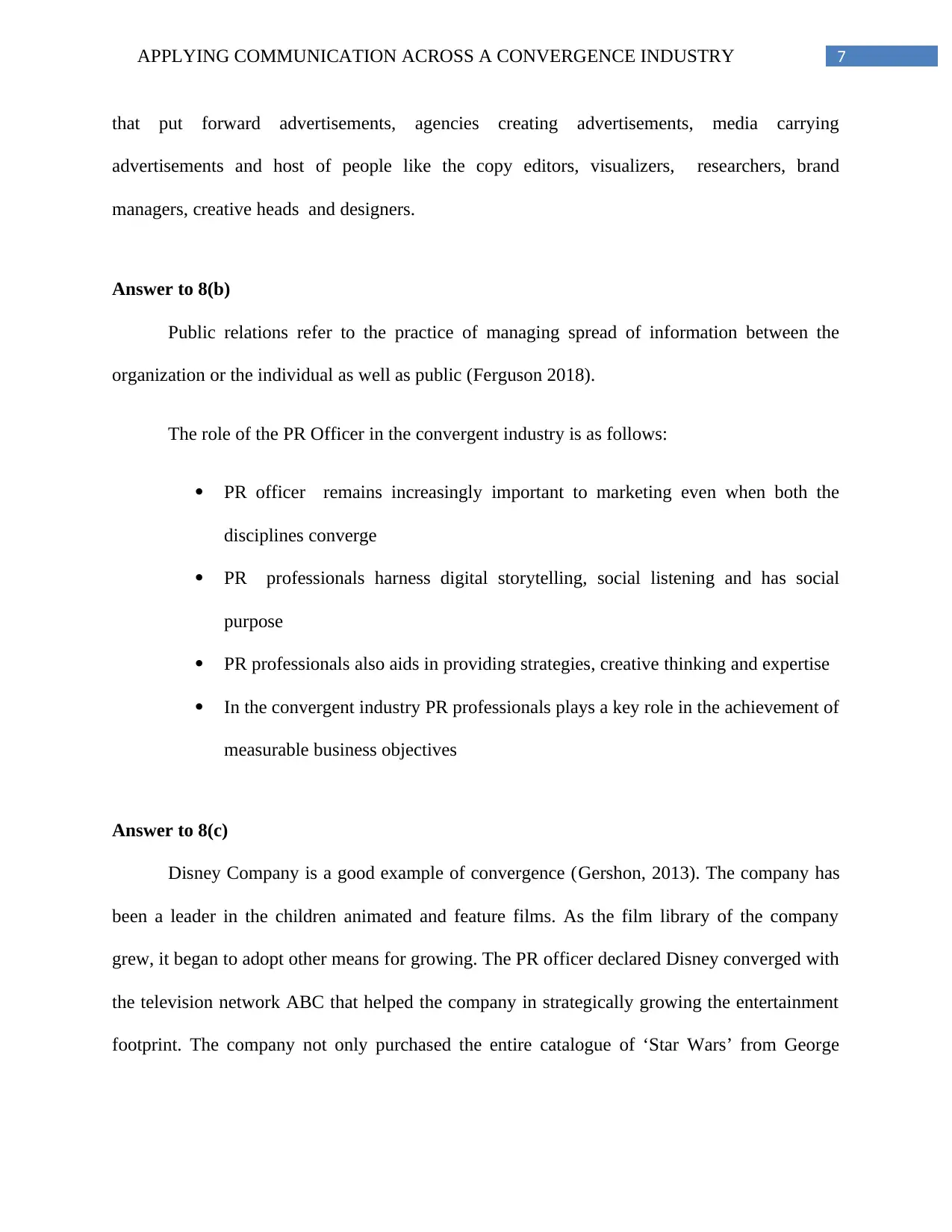
7APPLYING COMMUNICATION ACROSS A CONVERGENCE INDUSTRY
that put forward advertisements, agencies creating advertisements, media carrying
advertisements and host of people like the copy editors, visualizers, researchers, brand
managers, creative heads and designers.
Answer to 8(b)
Public relations refer to the practice of managing spread of information between the
organization or the individual as well as public (Ferguson 2018).
The role of the PR Officer in the convergent industry is as follows:
PR officer remains increasingly important to marketing even when both the
disciplines converge
PR professionals harness digital storytelling, social listening and has social
purpose
PR professionals also aids in providing strategies, creative thinking and expertise
In the convergent industry PR professionals plays a key role in the achievement of
measurable business objectives
Answer to 8(c)
Disney Company is a good example of convergence (Gershon, 2013). The company has
been a leader in the children animated and feature films. As the film library of the company
grew, it began to adopt other means for growing. The PR officer declared Disney converged with
the television network ABC that helped the company in strategically growing the entertainment
footprint. The company not only purchased the entire catalogue of ‘Star Wars’ from George
that put forward advertisements, agencies creating advertisements, media carrying
advertisements and host of people like the copy editors, visualizers, researchers, brand
managers, creative heads and designers.
Answer to 8(b)
Public relations refer to the practice of managing spread of information between the
organization or the individual as well as public (Ferguson 2018).
The role of the PR Officer in the convergent industry is as follows:
PR officer remains increasingly important to marketing even when both the
disciplines converge
PR professionals harness digital storytelling, social listening and has social
purpose
PR professionals also aids in providing strategies, creative thinking and expertise
In the convergent industry PR professionals plays a key role in the achievement of
measurable business objectives
Answer to 8(c)
Disney Company is a good example of convergence (Gershon, 2013). The company has
been a leader in the children animated and feature films. As the film library of the company
grew, it began to adopt other means for growing. The PR officer declared Disney converged with
the television network ABC that helped the company in strategically growing the entertainment
footprint. The company not only purchased the entire catalogue of ‘Star Wars’ from George

8APPLYING COMMUNICATION ACROSS A CONVERGENCE INDUSTRY
Lucas but also the animation studio ‘Pixar’. The PR officers played a key role in this
convergence by enabling Disney in achieving measurable business objectives.
Answer to 9 (a)
Direct marketing refers to the promotional methods involving the presentation of
information about the product, company or service of the target consumer without incorporating
an advertising intermediary (Risselada, Verhoef & Bijmolt, 2014). Some of the examples of
direct marketing includes, email, telemarketing, door-to-door selling and voicemail marketing.
Answer to 9 (b)
Sales refer to the activities of selling or the number of goods as well as services with a
given period (Johnston & Marshall, 2013).
The concepts of marketing and sales are same although they have very little differences.
The key difference between the two lies in the fact that the concept of sales is focused on product
while the concept of marketing focuses on the consumer needs.
Answer to 9 (c)
Market research refers to the organized effort of gathering information about the
consumers or the target market. It represents a vital component of business strategy (Babin &
Zikmund, 2015).
Answer to 9 (d)
Marketing analytics refers to means of managing, measuring and analysis of marketing
performance for maximizing the effectiveness and optimizing the return on the investment.
Lucas but also the animation studio ‘Pixar’. The PR officers played a key role in this
convergence by enabling Disney in achieving measurable business objectives.
Answer to 9 (a)
Direct marketing refers to the promotional methods involving the presentation of
information about the product, company or service of the target consumer without incorporating
an advertising intermediary (Risselada, Verhoef & Bijmolt, 2014). Some of the examples of
direct marketing includes, email, telemarketing, door-to-door selling and voicemail marketing.
Answer to 9 (b)
Sales refer to the activities of selling or the number of goods as well as services with a
given period (Johnston & Marshall, 2013).
The concepts of marketing and sales are same although they have very little differences.
The key difference between the two lies in the fact that the concept of sales is focused on product
while the concept of marketing focuses on the consumer needs.
Answer to 9 (c)
Market research refers to the organized effort of gathering information about the
consumers or the target market. It represents a vital component of business strategy (Babin &
Zikmund, 2015).
Answer to 9 (d)
Marketing analytics refers to means of managing, measuring and analysis of marketing
performance for maximizing the effectiveness and optimizing the return on the investment.
⊘ This is a preview!⊘
Do you want full access?
Subscribe today to unlock all pages.

Trusted by 1+ million students worldwide
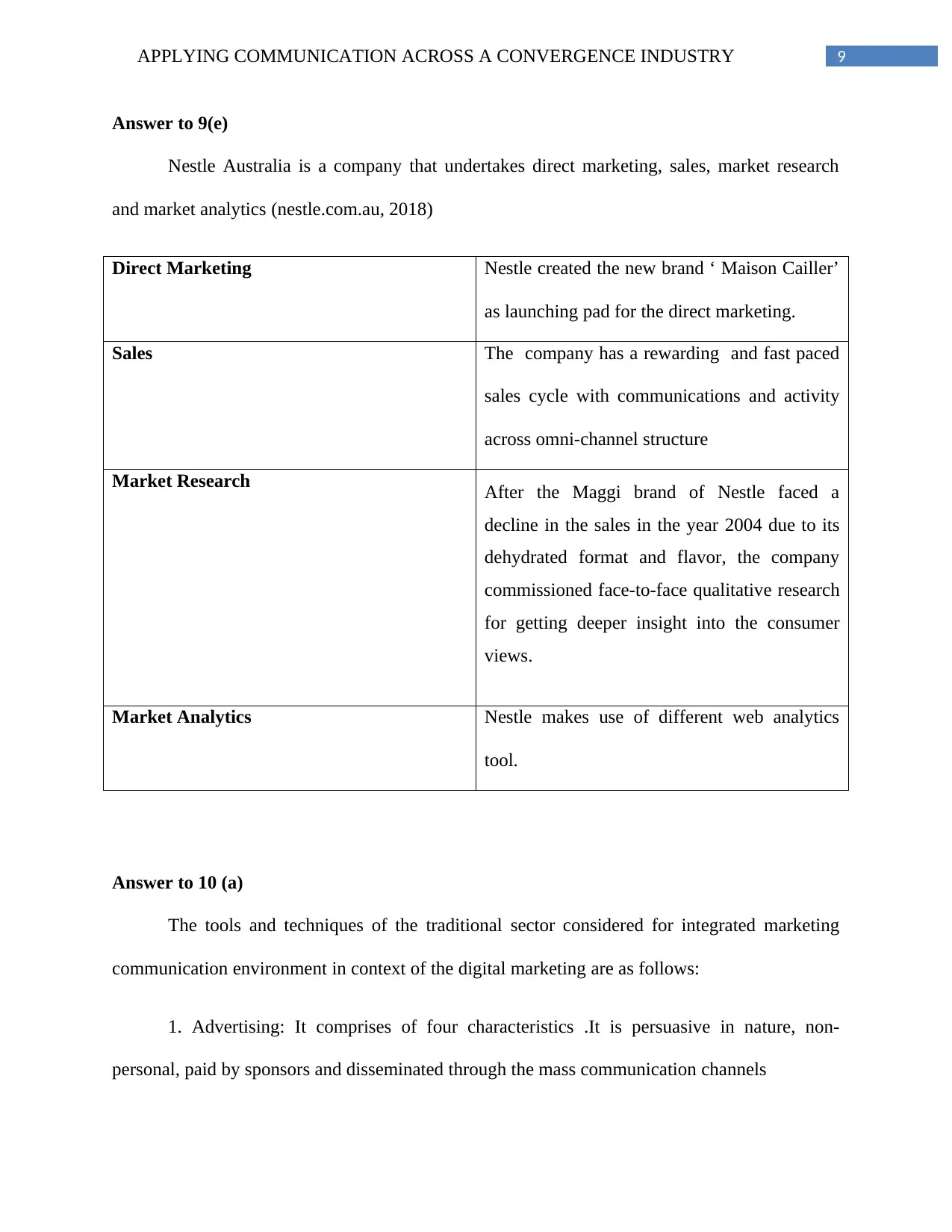
9APPLYING COMMUNICATION ACROSS A CONVERGENCE INDUSTRY
Answer to 9(e)
Nestle Australia is a company that undertakes direct marketing, sales, market research
and market analytics (nestle.com.au, 2018)
Direct Marketing Nestle created the new brand ‘ Maison Cailler’
as launching pad for the direct marketing.
Sales The company has a rewarding and fast paced
sales cycle with communications and activity
across omni-channel structure
Market Research After the Maggi brand of Nestle faced a
decline in the sales in the year 2004 due to its
dehydrated format and flavor, the company
commissioned face-to-face qualitative research
for getting deeper insight into the consumer
views.
Market Analytics Nestle makes use of different web analytics
tool.
Answer to 10 (a)
The tools and techniques of the traditional sector considered for integrated marketing
communication environment in context of the digital marketing are as follows:
1. Advertising: It comprises of four characteristics .It is persuasive in nature, non-
personal, paid by sponsors and disseminated through the mass communication channels
Answer to 9(e)
Nestle Australia is a company that undertakes direct marketing, sales, market research
and market analytics (nestle.com.au, 2018)
Direct Marketing Nestle created the new brand ‘ Maison Cailler’
as launching pad for the direct marketing.
Sales The company has a rewarding and fast paced
sales cycle with communications and activity
across omni-channel structure
Market Research After the Maggi brand of Nestle faced a
decline in the sales in the year 2004 due to its
dehydrated format and flavor, the company
commissioned face-to-face qualitative research
for getting deeper insight into the consumer
views.
Market Analytics Nestle makes use of different web analytics
tool.
Answer to 10 (a)
The tools and techniques of the traditional sector considered for integrated marketing
communication environment in context of the digital marketing are as follows:
1. Advertising: It comprises of four characteristics .It is persuasive in nature, non-
personal, paid by sponsors and disseminated through the mass communication channels
Paraphrase This Document
Need a fresh take? Get an instant paraphrase of this document with our AI Paraphraser
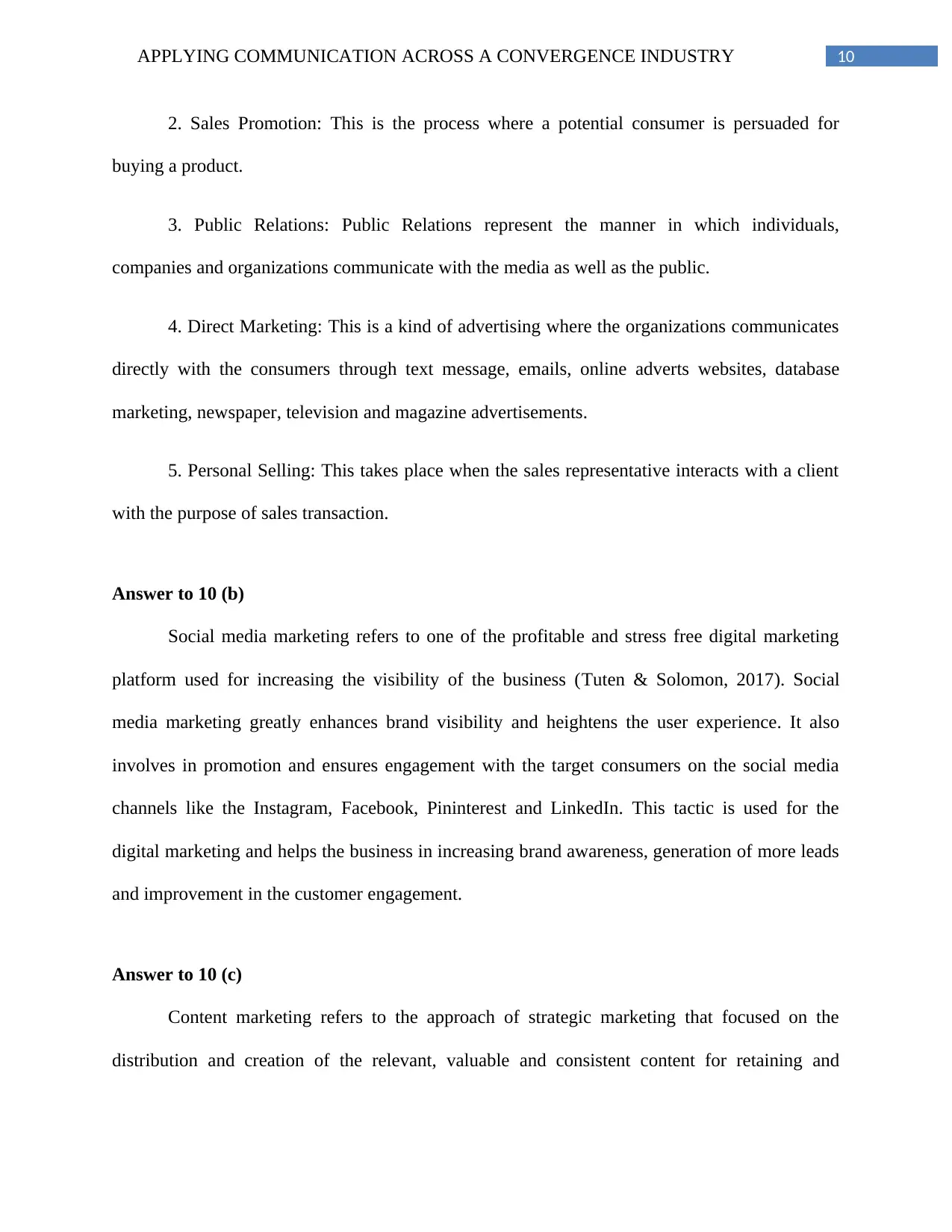
10APPLYING COMMUNICATION ACROSS A CONVERGENCE INDUSTRY
2. Sales Promotion: This is the process where a potential consumer is persuaded for
buying a product.
3. Public Relations: Public Relations represent the manner in which individuals,
companies and organizations communicate with the media as well as the public.
4. Direct Marketing: This is a kind of advertising where the organizations communicates
directly with the consumers through text message, emails, online adverts websites, database
marketing, newspaper, television and magazine advertisements.
5. Personal Selling: This takes place when the sales representative interacts with a client
with the purpose of sales transaction.
Answer to 10 (b)
Social media marketing refers to one of the profitable and stress free digital marketing
platform used for increasing the visibility of the business (Tuten & Solomon, 2017). Social
media marketing greatly enhances brand visibility and heightens the user experience. It also
involves in promotion and ensures engagement with the target consumers on the social media
channels like the Instagram, Facebook, Pininterest and LinkedIn. This tactic is used for the
digital marketing and helps the business in increasing brand awareness, generation of more leads
and improvement in the customer engagement.
Answer to 10 (c)
Content marketing refers to the approach of strategic marketing that focused on the
distribution and creation of the relevant, valuable and consistent content for retaining and
2. Sales Promotion: This is the process where a potential consumer is persuaded for
buying a product.
3. Public Relations: Public Relations represent the manner in which individuals,
companies and organizations communicate with the media as well as the public.
4. Direct Marketing: This is a kind of advertising where the organizations communicates
directly with the consumers through text message, emails, online adverts websites, database
marketing, newspaper, television and magazine advertisements.
5. Personal Selling: This takes place when the sales representative interacts with a client
with the purpose of sales transaction.
Answer to 10 (b)
Social media marketing refers to one of the profitable and stress free digital marketing
platform used for increasing the visibility of the business (Tuten & Solomon, 2017). Social
media marketing greatly enhances brand visibility and heightens the user experience. It also
involves in promotion and ensures engagement with the target consumers on the social media
channels like the Instagram, Facebook, Pininterest and LinkedIn. This tactic is used for the
digital marketing and helps the business in increasing brand awareness, generation of more leads
and improvement in the customer engagement.
Answer to 10 (c)
Content marketing refers to the approach of strategic marketing that focused on the
distribution and creation of the relevant, valuable and consistent content for retaining and
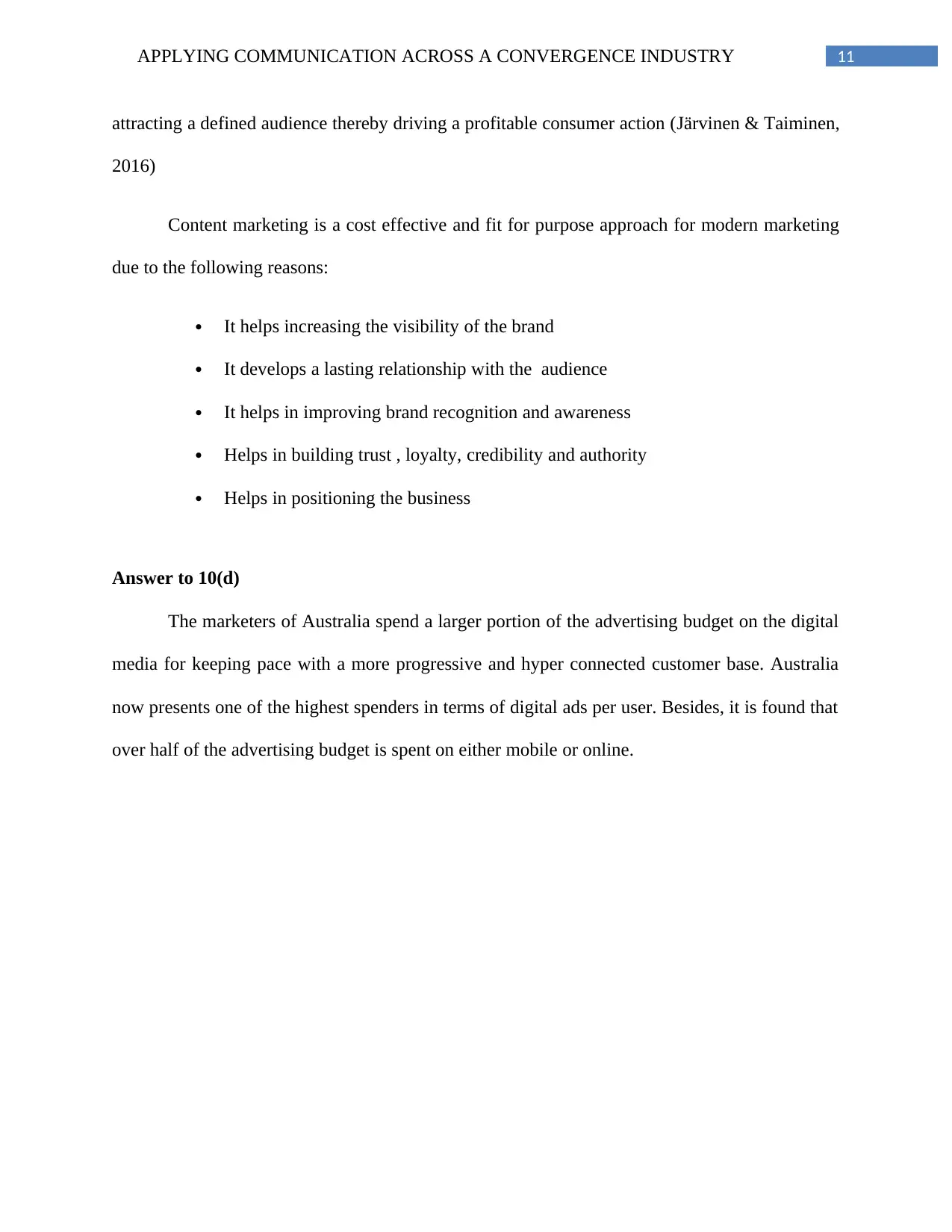
11APPLYING COMMUNICATION ACROSS A CONVERGENCE INDUSTRY
attracting a defined audience thereby driving a profitable consumer action (Järvinen & Taiminen,
2016)
Content marketing is a cost effective and fit for purpose approach for modern marketing
due to the following reasons:
It helps increasing the visibility of the brand
It develops a lasting relationship with the audience
It helps in improving brand recognition and awareness
Helps in building trust , loyalty, credibility and authority
Helps in positioning the business
Answer to 10(d)
The marketers of Australia spend a larger portion of the advertising budget on the digital
media for keeping pace with a more progressive and hyper connected customer base. Australia
now presents one of the highest spenders in terms of digital ads per user. Besides, it is found that
over half of the advertising budget is spent on either mobile or online.
attracting a defined audience thereby driving a profitable consumer action (Järvinen & Taiminen,
2016)
Content marketing is a cost effective and fit for purpose approach for modern marketing
due to the following reasons:
It helps increasing the visibility of the brand
It develops a lasting relationship with the audience
It helps in improving brand recognition and awareness
Helps in building trust , loyalty, credibility and authority
Helps in positioning the business
Answer to 10(d)
The marketers of Australia spend a larger portion of the advertising budget on the digital
media for keeping pace with a more progressive and hyper connected customer base. Australia
now presents one of the highest spenders in terms of digital ads per user. Besides, it is found that
over half of the advertising budget is spent on either mobile or online.
⊘ This is a preview!⊘
Do you want full access?
Subscribe today to unlock all pages.

Trusted by 1+ million students worldwide
1 out of 29
Related Documents
Your All-in-One AI-Powered Toolkit for Academic Success.
+13062052269
info@desklib.com
Available 24*7 on WhatsApp / Email
![[object Object]](/_next/static/media/star-bottom.7253800d.svg)
Unlock your academic potential
Copyright © 2020–2025 A2Z Services. All Rights Reserved. Developed and managed by ZUCOL.




